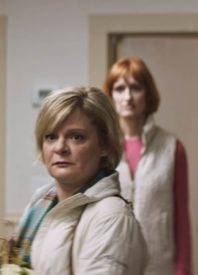
Some critics have written about their ambivalent feelings about Fran Kranz’ debut film Mass. And the ambivalence is less about the quality of the work and more about certain expectations. Or maybe, it’s the lack of expectations when it comes to the debut feature from Fran Kranz. Should the guy who played an affable nerd in Cabin in the Woods come out with an affably nerdy film or the exact opposite, whatever that is? Either way, the director finds necessary levity and digressions in his film. There’s a part of it where Ann Dowd plays a character, Linda, who talks about snails. The monologue about snails was short enough.
But snails also are one of the last things anyone wants to hear. That’s especially true in hearing that in the basement of a church with ambiguous denomination. At the brink of their patience are her husband Richard (Reed Birney), and another couple, Jay and Gail (Jason Isaacs and Martha Plimpton). Patience is a virtue these characters express through words but definitely not through the faces they make. These characters, after all, are not here to hear about snails but because of a mediation process. Linda and Richard’s offscreen son Hayden is a school bomber and shooter. Hayden dies by suicide but not before killing a few younger students, among them Jay and Gail’s offscreen son.
The film’s few scenes takes places years after that shooting. After litigation that Jay and Gail avoided, when all parties can speak about their version of the event. Viewers will probably take sides as to whether or not they will attend such a mediation had they endured the similar situation. Either way, during one moment, Richard talks about being at work during the event. But the camera subtly cuts to Jay’s increasingly angry face. His face asks a question that eventually pops up during this tense conversation. That question is where are Linda and Richard? Where are they as Hayden starts showing signs of wanting to harm others and himself?
That question, and the act of expressing it, reminds me of what Roger Ebert once said about cinema. He once said that cinema is an empathy machine but that feels like a big leap. And I want to break down that statement into a few smaller steps. First, I want to apologize for aiming to be profound for something that someone probably already wrote before. Now that that’s out of the way, there’s a smaller step a film takes. That step gets viewers to empathize with the characters on screen. Specifically, the film has to show the appropriate and justifiable amounts of pain. Kranz’ camera catches the pain that his four actors express for their characters.
Here viewers see Jay’s posture, Gail’s occasional hand gestures, Linda’s inquisitiveness, Richard’s understandable stoicism. Dowd has the most awards hype because of her work in this film. But she and Birney do this thing when Jay and Gail get justifiably angry. In turn, they feel insulted, but can’t vocalize their emotions. Remarkable subtle work. I’ve already noted the subtle editing work to show how much of the film is reacting to each other’s words. There’s also some interestingly subtle costume choices here that say so much about the dignity these characters what to express. There’s also the impression here that Kranz had to fight to cast these actors, a fight that he thankfully won.
- Release Date: 10/15/2021


